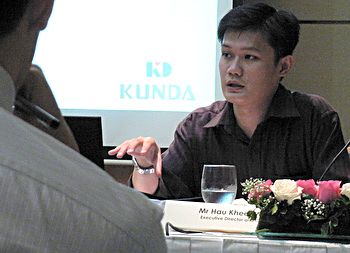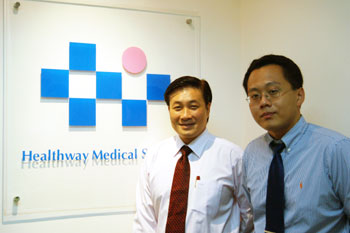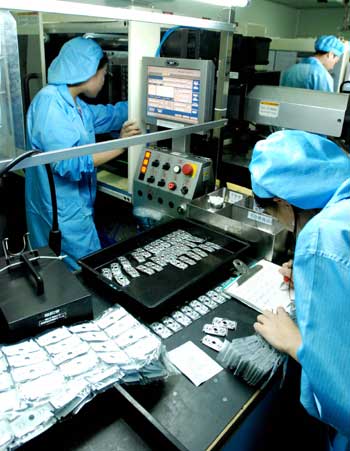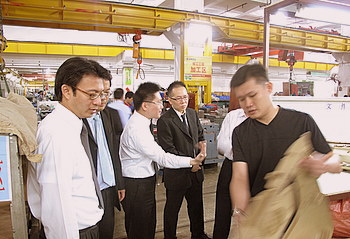
China Kunda CFO Hau Khee Wee displays soft moulded products to Mr. Leon Chiang, left, of Wintan Investment Corp, and other fund managers. Photo by Terence Wong
CHINA KUNDA Technology Holding Ltd is not your grandparents’ mould shop. The company, which last year celebrated both its listing on the Singapore mainboard and its 10th anniversary, has made a decided and determined transformation in terms of both quality and quantity over the past 11 years.
Founded by Executive Chairman and CEO Mr. Cai Kaoqun in Shenzhen, the company began modestly, starting with ordinary, plastic injection part moulds for cell phone handsets.
But Kunda gradually ascended the value-added totem pole to focus on in-mould decoration production (IMD), producing high-end moulds for computer and automobile parts, and now exports the bulk of its products.
In 1998, Mr. Cai established the company’s operations in Hong Kong and Shenzhen, supplying plastic moulding services to Hong Kong and Taiwanese enterprises.
“We started with handset moulds, then computers, and now car parts. IMD is at our core now, and we export a lot, especially to the EU. We followed the model of import replacement to exports, and our development model now is increasingly based on auto parts and accessories for which there is much room for further growth,” he said.
The firm now exports a whopping 70% of its moulds overseas. However, Mr Cai was cognizant of the risk that overreliance on overseas markets could bring to Kunda.
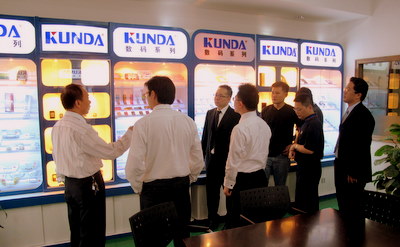
China Kunda Executive Director and Chief Operating Officer Yang Jinbiao, left, showcasing wide array of company’s products to fund managers. Photo by Terence Wong
He said that globalization was a challenge faced by many Chinese enterprises, and the current US financial meltdown also provided a somewhat difficult environment for the company’s recent listing in Singapore. He said the company’s ultimate goal was “globalization of our operations.”
“We need to be cautious in our decisions and strengthen our understanding of the global market.” But one thing that was not a major concern was the benchmark global crude oil price.
“Only about 20% of our costs are from (petroleum-based) plastic prices. Metals account for more, but our prices are set in advance by long-term contract,” Mr. Cai said, adding that “in fact, raw material costs comprise a very small portion of our overall expenses.”
The current anemic demand in its two major markets – the EU and the US – was no excuse to sit idly by while competitors upgraded their production facilities and expanded their offerings.
"We’ve constantly been moving to upgrade to higher levels in terms of both skills and technology, from the development of our own proprietary technology through our own research and development (R&D) team,” Mr. Cai said.
In 2006, Kunda set up a joint R&D facility with China’s Hua Zhong University in order to introduce and absorb international advanced mould technology. In addition, the company also established a Postdoctoral Scientific Research Base with the South China University of Technology as well a inking a technical cooperation tieup with Hong Kong University of Science and Technology.
“These moves are part of our overall strategy to develop our own internal pool of talent and build up our proprietary technology platform,” he said.
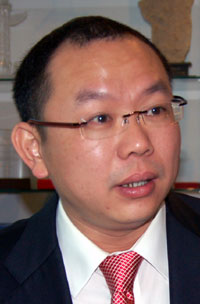
Cai Kaoqun, chairman and CEO, China Kunda. Photo by Sim Kih.
The company’s products may not be glaringly visible to consumers worldwide, but for anyone who has ever driven a BMW, Mercedes, Volkswagen, Audi, Ford, GM, Honda or Toyota, chances are quite good that the vehicle’s dashboard, door handles, manifolds, mirror casings or a cornucopia of other parts were moulded by Kunda’s products.
Its IMD/IML moulds are also used in products made by global electronics mega-brands including Philips, LG, and Toshiba, as well as China’s own Founder, Midea and several others.
Located in Shenzhen, Kunda occupies 40.000 square meters producing mould sets, injection products and IMD parts.
High technology
China Kunda CFO Hau Khee Wee noted the worsening global economic outlook and the clouds over key customers in the US auto industry.
But he said Kunda is seeing less downside pressure than some of its competitors, partly due to its relatively high level of technology.
"We see ourselves as a fairly technology-intensive company. We have dual core production. So in the event of a slowdown, we actually think that we have a stronger competitive advantage," said Hau.
The company saw its net profits rise 6% to 27.6 mln hkd in the first fiscal half to September 2008.
"The established export market is actually working in our favor because now manufacturers have a stronger urgency to really control their costs, so we are actually seeing more inquiries from these types of customers," he said.
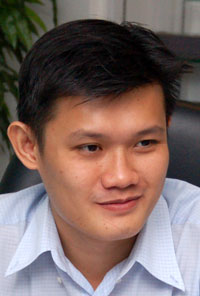
CFO Hau Khee Wee. Photo by Sim Kih
China Kunda's auto mould operations fall under two main categories.
"For auto moulds, we make two kinds that are very technologically intensive. One is a mould for plastic heads to produce manifolds, the part that draws air into the engine. We use plastic instead of steel which actually cuts fuel consumption up to eight pct. Second is our low-bridge air moulding which is mainly used for car interior parts," Hau said.
He said that for key client Disney, Kunda was not overly exposed to problems with intellectual property rights violations in China.
"For Disney, we actually supply to the OEM contractor/manufacturer, so we don't really do finished products for them. We supply IMD parts for their assembly and don't see any direct issues for the IPR problem. For IMD there is a scarcity of supply in the market, so we actually have the luxury to cherry pick our orders."
The company may also benefit from China's promotion of the domestic precision moulds sector and its drive towards import substitution.
"In terms of demand for our products, we are still cautiously optimistic because China is now the factory for the world. But at the same time, China has to import a lot of moulds in order for them to carry out production."
The country imported around 2.5 bln usd worth of precision plastic moulds in 2006, making it the world's leading importer in this segment.
"We are manufacturing all these precision moulds which are used by China to carry out all this production that previously had to be imported," said Hau.
He said the central government was also promoting the growth of the domestic precision mould making sector.
"The Chinese government is trying to actively support local automakers, so there have been some preliminary talks with some local components makers in China on cooperation. The technical expertise for automobile components in China is quite limited, and there is a now a very strong reliance on foreign precision mould and IMD suppliers.
"The Chinese government is strongly trying to cultivate a pool of local Chinese component makers that is able to serve their local brands."
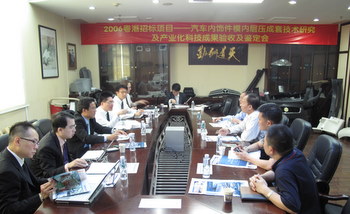
China Kunda senior management meets at their Shenzhen plant with Greater China team of fund managers. Photo by Terence Wong
Kunda is open to either organic growth or expansion through mergers and acquisitions, according to Hau.
"We are looking at a variety of ways to expand ourselves. For the mould segment we are open to acquisition of some downstream suppliers," Hau said.
He said that the potential to expand sales is still considerable despite the overall market weakness.
"At this stage in time, because of our market position I think we have a fairly big potential market to tap. A lot of our products are exported, mainly to the EU and US, mainly because mould making is a fairly expensive trade in developed countries. At the same time, it is a trade that is slowly declining there as young people in the West today don't want to be mould makers."
Hau said the opposite was true at home.
"Conversely in China, it is a trade that pays very well and a lot of people are willing to do it."
On October 9, 2008, Kunda raised around 11.64 mln sgd from the sale of 95.2 mln shares in its initial public offer. The company said it would use the proceeds for acquisitions, expansion, research and development and for sales and marketing.
Nov 2008 story: CHINA KUNDA update: 1H09 analyst briefing Q&A


